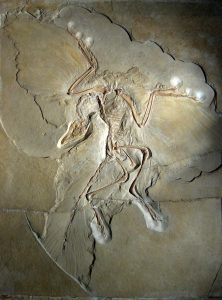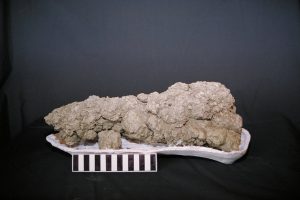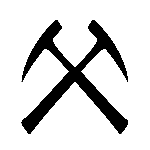7.3: Fossils
- Page ID
- 28252
\( \newcommand{\vecs}[1]{\overset { \scriptstyle \rightharpoonup} {\mathbf{#1}} } \)
\( \newcommand{\vecd}[1]{\overset{-\!-\!\rightharpoonup}{\vphantom{a}\smash {#1}}} \)
\( \newcommand{\id}{\mathrm{id}}\) \( \newcommand{\Span}{\mathrm{span}}\)
( \newcommand{\kernel}{\mathrm{null}\,}\) \( \newcommand{\range}{\mathrm{range}\,}\)
\( \newcommand{\RealPart}{\mathrm{Re}}\) \( \newcommand{\ImaginaryPart}{\mathrm{Im}}\)
\( \newcommand{\Argument}{\mathrm{Arg}}\) \( \newcommand{\norm}[1]{\| #1 \|}\)
\( \newcommand{\inner}[2]{\langle #1, #2 \rangle}\)
\( \newcommand{\Span}{\mathrm{span}}\)
\( \newcommand{\id}{\mathrm{id}}\)
\( \newcommand{\Span}{\mathrm{span}}\)
\( \newcommand{\kernel}{\mathrm{null}\,}\)
\( \newcommand{\range}{\mathrm{range}\,}\)
\( \newcommand{\RealPart}{\mathrm{Re}}\)
\( \newcommand{\ImaginaryPart}{\mathrm{Im}}\)
\( \newcommand{\Argument}{\mathrm{Arg}}\)
\( \newcommand{\norm}[1]{\| #1 \|}\)
\( \newcommand{\inner}[2]{\langle #1, #2 \rangle}\)
\( \newcommand{\Span}{\mathrm{span}}\) \( \newcommand{\AA}{\unicode[.8,0]{x212B}}\)
\( \newcommand{\vectorA}[1]{\vec{#1}} % arrow\)
\( \newcommand{\vectorAt}[1]{\vec{\text{#1}}} % arrow\)
\( \newcommand{\vectorB}[1]{\overset { \scriptstyle \rightharpoonup} {\mathbf{#1}} } \)
\( \newcommand{\vectorC}[1]{\textbf{#1}} \)
\( \newcommand{\vectorD}[1]{\overrightarrow{#1}} \)
\( \newcommand{\vectorDt}[1]{\overrightarrow{\text{#1}}} \)
\( \newcommand{\vectE}[1]{\overset{-\!-\!\rightharpoonup}{\vphantom{a}\smash{\mathbf {#1}}}} \)
\( \newcommand{\vecs}[1]{\overset { \scriptstyle \rightharpoonup} {\mathbf{#1}} } \)
\( \newcommand{\vecd}[1]{\overset{-\!-\!\rightharpoonup}{\vphantom{a}\smash {#1}}} \)
\(\newcommand{\avec}{\mathbf a}\) \(\newcommand{\bvec}{\mathbf b}\) \(\newcommand{\cvec}{\mathbf c}\) \(\newcommand{\dvec}{\mathbf d}\) \(\newcommand{\dtil}{\widetilde{\mathbf d}}\) \(\newcommand{\evec}{\mathbf e}\) \(\newcommand{\fvec}{\mathbf f}\) \(\newcommand{\nvec}{\mathbf n}\) \(\newcommand{\pvec}{\mathbf p}\) \(\newcommand{\qvec}{\mathbf q}\) \(\newcommand{\svec}{\mathbf s}\) \(\newcommand{\tvec}{\mathbf t}\) \(\newcommand{\uvec}{\mathbf u}\) \(\newcommand{\vvec}{\mathbf v}\) \(\newcommand{\wvec}{\mathbf w}\) \(\newcommand{\xvec}{\mathbf x}\) \(\newcommand{\yvec}{\mathbf y}\) \(\newcommand{\zvec}{\mathbf z}\) \(\newcommand{\rvec}{\mathbf r}\) \(\newcommand{\mvec}{\mathbf m}\) \(\newcommand{\zerovec}{\mathbf 0}\) \(\newcommand{\onevec}{\mathbf 1}\) \(\newcommand{\real}{\mathbb R}\) \(\newcommand{\twovec}[2]{\left[\begin{array}{r}#1 \\ #2 \end{array}\right]}\) \(\newcommand{\ctwovec}[2]{\left[\begin{array}{c}#1 \\ #2 \end{array}\right]}\) \(\newcommand{\threevec}[3]{\left[\begin{array}{r}#1 \\ #2 \\ #3 \end{array}\right]}\) \(\newcommand{\cthreevec}[3]{\left[\begin{array}{c}#1 \\ #2 \\ #3 \end{array}\right]}\) \(\newcommand{\fourvec}[4]{\left[\begin{array}{r}#1 \\ #2 \\ #3 \\ #4 \end{array}\right]}\) \(\newcommand{\cfourvec}[4]{\left[\begin{array}{c}#1 \\ #2 \\ #3 \\ #4 \end{array}\right]}\) \(\newcommand{\fivevec}[5]{\left[\begin{array}{r}#1 \\ #2 \\ #3 \\ #4 \\ #5 \\ \end{array}\right]}\) \(\newcommand{\cfivevec}[5]{\left[\begin{array}{c}#1 \\ #2 \\ #3 \\ #4 \\ #5 \\ \end{array}\right]}\) \(\newcommand{\mattwo}[4]{\left[\begin{array}{rr}#1 \amp #2 \\ #3 \amp #4 \\ \end{array}\right]}\) \(\newcommand{\laspan}[1]{\text{Span}\{#1\}}\) \(\newcommand{\bcal}{\cal B}\) \(\newcommand{\ccal}{\cal C}\) \(\newcommand{\scal}{\cal S}\) \(\newcommand{\wcal}{\cal W}\) \(\newcommand{\ecal}{\cal E}\) \(\newcommand{\coords}[2]{\left\{#1\right\}_{#2}}\) \(\newcommand{\gray}[1]{\color{gray}{#1}}\) \(\newcommand{\lgray}[1]{\color{lightgray}{#1}}\) \(\newcommand{\rank}{\operatorname{rank}}\) \(\newcommand{\row}{\text{Row}}\) \(\newcommand{\col}{\text{Col}}\) \(\renewcommand{\row}{\text{Row}}\) \(\newcommand{\nul}{\text{Nul}}\) \(\newcommand{\var}{\text{Var}}\) \(\newcommand{\corr}{\text{corr}}\) \(\newcommand{\len}[1]{\left|#1\right|}\) \(\newcommand{\bbar}{\overline{\bvec}}\) \(\newcommand{\bhat}{\widehat{\bvec}}\) \(\newcommand{\bperp}{\bvec^\perp}\) \(\newcommand{\xhat}{\widehat{\xvec}}\) \(\newcommand{\vhat}{\widehat{\vvec}}\) \(\newcommand{\uhat}{\widehat{\uvec}}\) \(\newcommand{\what}{\widehat{\wvec}}\) \(\newcommand{\Sighat}{\widehat{\Sigma}}\) \(\newcommand{\lt}{<}\) \(\newcommand{\gt}{>}\) \(\newcommand{\amp}{&}\) \(\definecolor{fillinmathshade}{gray}{0.9}\)
Fossils are any evidence of past life preserved in rocks. They may be actual remains of body parts (rare), impressions of soft body parts, casts and molds of body parts (more common), body parts replaced by mineral (common) or evidence of animal behavior such as footprints and burrows. The body parts of living organisms range from the hard bones and shells of animals, soft cellulose of plants, soft bodies of jellyfish, down to single cells of bacteria and algae. Which body parts can be preserved? The vast majority of life today consists of soft-bodied and/or single-celled organisms, and will not likely be preserved in the geologic record except under unusual conditions. The best environment for preservation is the ocean, yet marine processes can dissolve hard parts and scavenging can reduce or eliminate remains. Thus, even under ideal conditions in the ocean, the likelihood of preservation is quite limited. For terrestrial life, the possibility of remains being buried and preserved is even more limited. In other words, the fossil record is incomplete and records only a small percentage of life that existed. Although incomplete, fossil records are used for stratigraphic correlation, using the Principle of Faunal Succession, and provide a method used for establishing the age of a formation on the Geologic Time Scale.
Types of Preservation
![By Wilson44691 (Own work) [Public domain], <a data-cke-saved-href="https://commons.wikimedia.org/wiki/File%3AElrathiakingiUtahWheelerCambrian.jpg" href="https://commons.wikimedia.org/wiki/File%3AElrathiakingiUtahWheelerCambrian.jpg" Image of three lobes of an external skeleton like an insect has today.](http://opengeology.org/textbook/wp-content/uploads/2016/07/ElrathiakingiUtahWheelerCambrian-243x300.jpg)
Remnants or impressions of hard parts, such as a marine clamshell or dinosaur bone, are the most common types of fossils [24]. The original material has almost always been replaced with new minerals that preserve much of the shape of the original shell, bone, or cell. The common types of fossil preservation are actual preservation, permineralization, molds and casts, carbonization, and trace fossils.
Actual preservation is a rare form of fossilization where the original materials or hard parts of the organism are preserved. Preservation of soft-tissue is very rare since these organic materials easily disappear because of bacterial decay [24]. Examples of actual preservation are unaltered biological materials like insects in amber or original minerals like mother-of-pearl on the interior of a shell. Another example is mammoth skin and hair preserved in post-glacial deposits in the Arctic regions [25]. Rare mummification [26] have left fragments of soft tissue, skin, and sometimes even blood vessels of dinosaurs, from which proteins have been isolated and evidence for DNA fragments have been discovered [27].
![By Inglesenargentina (talk) (Uploads) (Own work) [Public domain], <a data-cke-saved-href="https://commons.wikimedia.org/wiki/File%3ABell-shaped-curve.JPG" href="https://commons.wikimedia.org/wiki/File%3ABell-shaped-curve.JPG" Mosquito trapped in amber in actal preservation](http://opengeology.org/textbook/wp-content/uploads/2016/07/07.19_mosquito_in_amber-300x206.jpg)

Permineralization occurs when an organism is buried, and then elements in groundwater completely impregnate all spaces within the body, even cells. Soft body structures can be preserved in great detail, but stronger materials like bone and teeth are the most likely to be preserved. Petrified wood is an example of detailed cellulose structures in the wood being preserved.
Molds and casts form when the original material of the organism dissolves and leaves a cavity in the surrounding rock. The shape of this cavity is an external mold. If the mold is subsequently filled with sediments or a mineral precipitate, the organism’s external shape is preserved as a cast. Sometimes internal cavities of organisms, such internal casts of clams, snails, and even skulls are preserved as internal casts showing details of soft structures. If the chemistry is right, and burial is rapid, mineral nodules form around soft structures preserving the three-dimensional detail.

![By Wilson44691 (Own work) [Public domain], <a data-cke-saved-href="https://commons.wikimedia.org/wiki/File%3AViburnumFossil.jpg" href="https://commons.wikimedia.org/wiki/File%3AViburnumFossil.jpg" carbonized leaf fossil showing insect damage and vein structure](http://opengeology.org/textbook/wp-content/uploads/2016/07/07.23_carbonization_of_ViburnumFossil-300x215.jpg)
Carbonization occurs when the organic tissues of an organism are compressed, the volatiles are driven out, and everything but the carbon disappears leaving a carbon silhouette of the original organism. Leaf and fern fossils are examples of carbonization [28].
Trace fossils are indirect evidence left behind by an organism, such as burrows and footprints, as it lived its life. Ichnology is specifically the study of prehistoric animal tracks. Dinosaur tracks testify to their presence and movement over an area and even provide information about their size, gait, speed, and behavior [29; 30]. Burrows dug by tunneling organisms tell of their presence and mode of life [31; 32; 33]. Other trace fossils include fossilized feces called coprolites [34] and stomach stones called gastroliths [35] that provide information about diet and habitat.


References
25. Dale Guthrie, R. Frozen Fauna of the Mammoth Steppe. (pu3430623_3430810, 1989).
30. Martin Lockley. Tracking dinosaurs: a new look at an ancient world. (1991).
32. Palaeobiology II. (Wiley-Blackwell, 2001).
35. Wm. Lee Stokes. Dinosaur gastroliths revisited. J. Paleontol. 61, 1242–1246 (1987).


